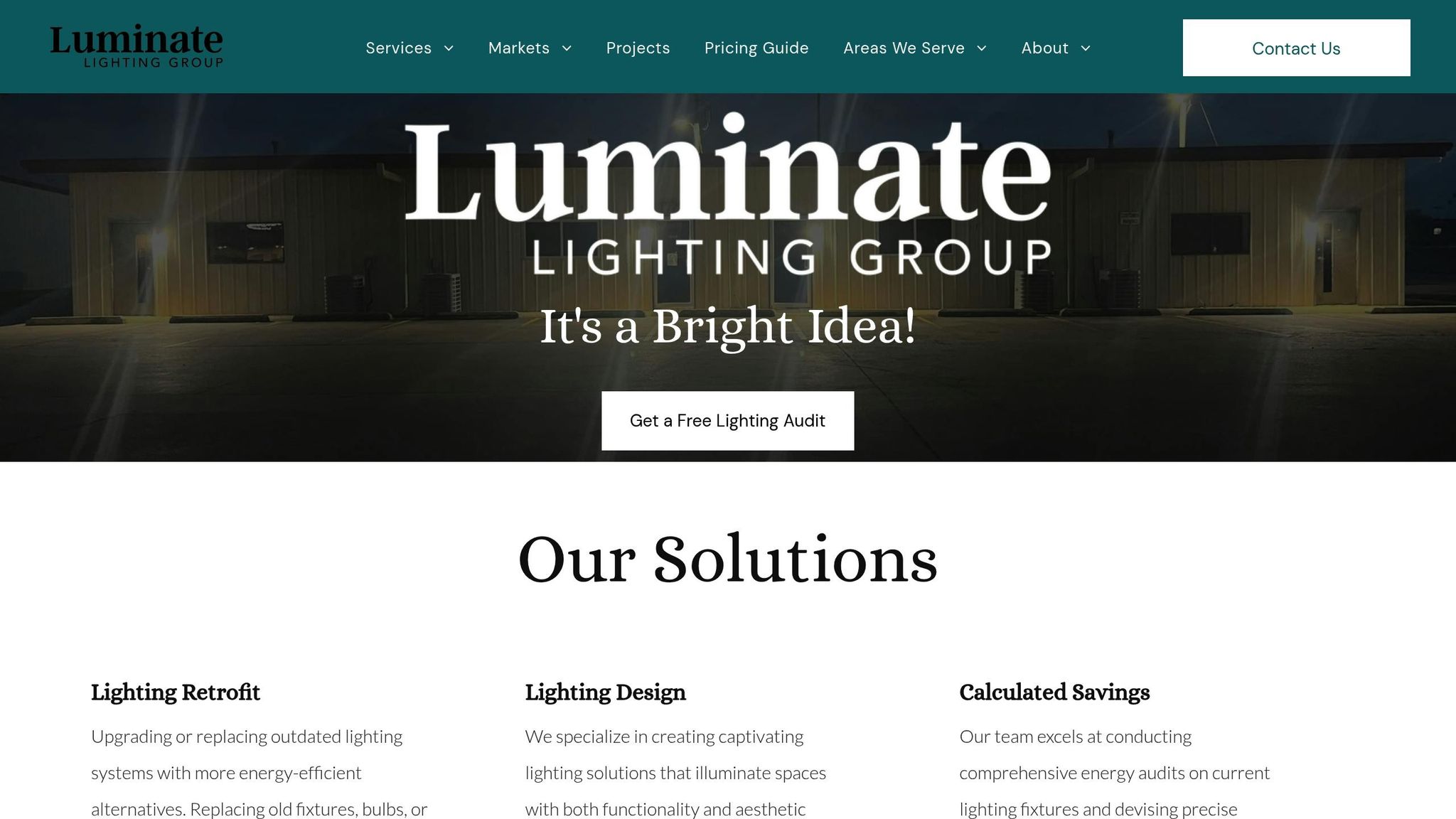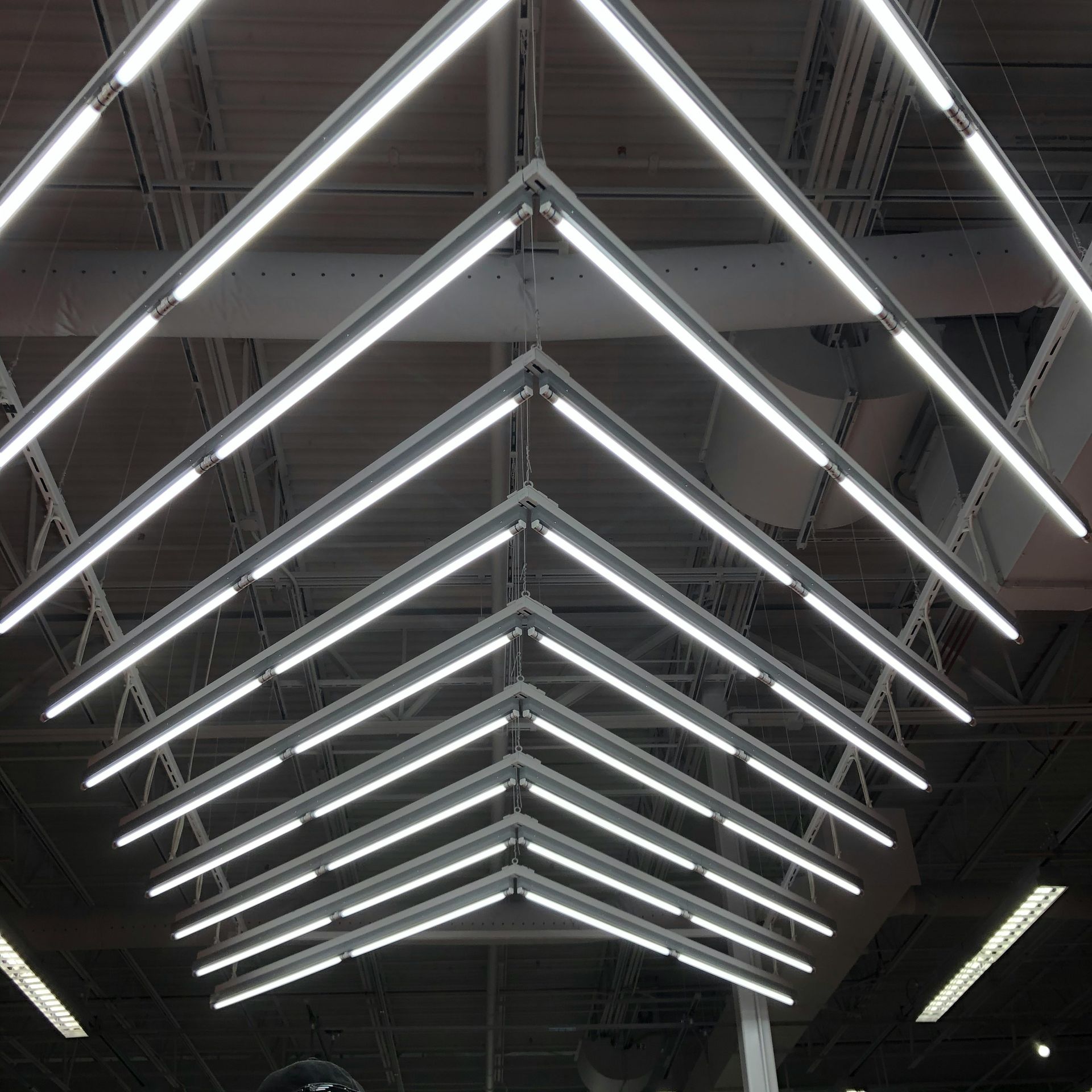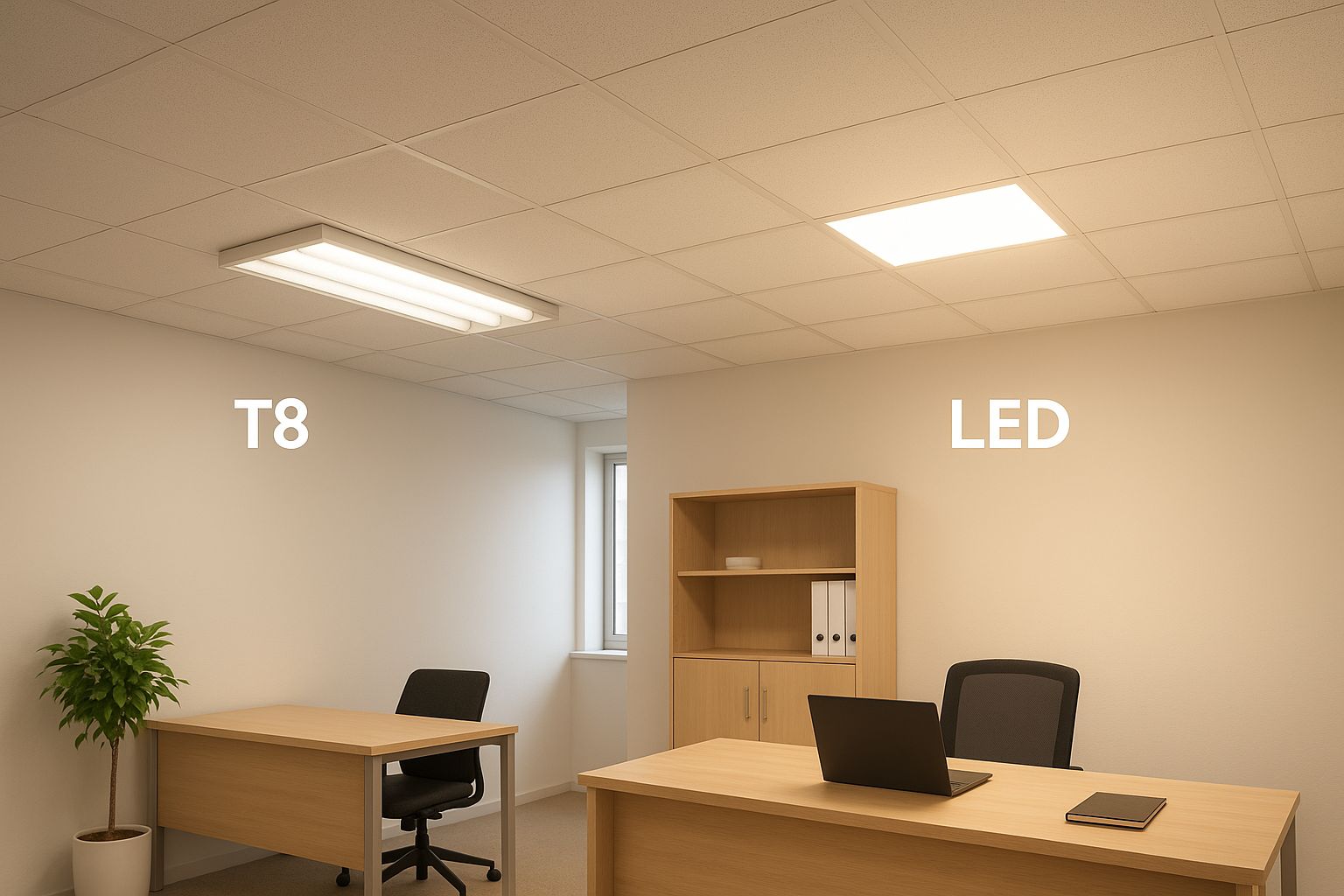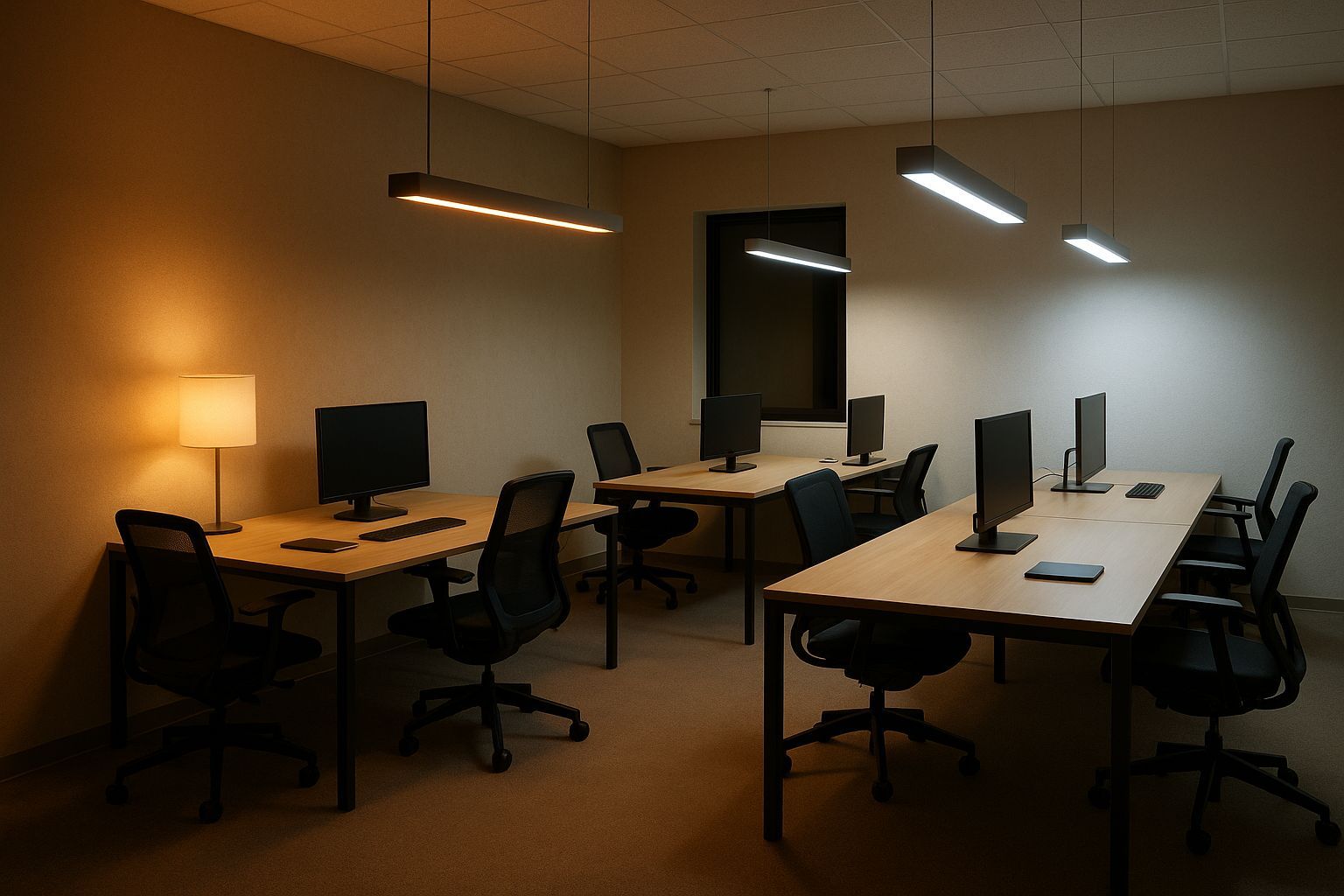Wireless Controls in LED Retrofit Projects
Wireless Controls in LED Retrofit Projects
Wireless lighting controls are transforming LED retrofits by cutting costs, saving energy, and simplifying installations. These systems eliminate traditional wiring, making upgrades faster and more efficient. Key benefits include:
- Energy Savings: Reduce lighting energy use by 30–60% with features like occupancy sensors and daylight harvesting.
- Lower Costs: Installation costs drop by up to 44%, and total ownership costs are 11% lower over five years compared to wired systems.
- Flexibility: Easily reconfigure or expand systems without rewiring, ideal for retrofits in challenging spaces.
- Fast Installation: Wireless setups can be completed 70% faster than wired systems, minimizing disruption.
While wireless systems offer impressive advantages, challenges like signal interference, compatibility with older infrastructure, and cybersecurity risks need careful planning. Businesses adopting these systems can achieve significant savings and operational improvements, especially when paired with LED technology. Luminate Lighting Group specializes in delivering tailored wireless solutions, ensuring seamless integration and long-term benefits.
nLight® AIR Wireless Lighting Controls System – Product Portfolio
Energy Efficiency Benefits of Wireless Controls
Wireless lighting controls offer a powerful way for U.S. businesses to cut energy use and reduce costs, especially when paired with LED retrofits. These advanced systems use smart features to ensure lighting is only used when necessary, leading to significant energy and cost savings.
How Wireless Controls Save Energy
Wireless controls conserve energy through three key strategies: occupancy sensing, daylight harvesting, and adaptive scheduling. These features work together to eliminate wasted lighting by turning lights on only when needed, dimming them as natural light increases, and adjusting brightness based on usage patterns.
In retrofit applications, these strategies deliver impressive results. A 2017 DesignLights Consortium (DLC) study found that networked lighting controls can achieve an average of 47% energy savings. Meanwhile, a meta-analysis by the Lawrence Berkeley National Laboratory revealed the following savings for individual strategies: 24% for occupancy-based controls, 28% for daylight harvesting, and 38% when multiple strategies are combined.
"Daylight harvesting using continuous dimming equipment automatically controlled by a photo sensor can generate 30 percent to 40 percent savings in lighting energy consumption, significantly reducing operating costs for the owner." – Western Michigan University
Unlike traditional on-off switches, wireless systems provide precise control, adjusting individual fixtures or groups of lights based on real-time conditions. This ensures lighting is optimized for both energy efficiency and comfort.
Research Data on Energy Reduction
Numerous studies highlight the energy savings achievable with wireless lighting controls, particularly when multiple strategies are integrated.
A standout example is the U.S. Department of Energy headquarters retrofit in 2016. By replacing fluorescent lamps with tubular LEDs and adding advanced controls, the project cut lighting energy use by about 50%, saving 2.4 million kWh annually. At $0.104 per kWh, this translates to nearly $258,000 in yearly energy cost savings.
Savings can vary depending on space usage. For example, motion sensor-controlled lighting in office workstations achieved 22% savings with a 30-minute delay, 32% with a 10-minute delay, and 46% with a 1-minute delay. Similarly, the Energy Center of Wisconsin found that re-commissioning daylight harvesting controls boosted savings from 23% to 43% in 20 spaces.
| Room Type | Energy Savings with Occupancy Sensors |
|---|---|
| Breakroom | 29% |
| Classroom | 40-46% |
| Conference Room | 45% |
| Corridor | 30-80% |
| Private Office | 13-50% |
| Open Office | 10% |
| Restroom | 30-90% |
| Storage Area | 45-80% |
| Warehouse | 35-54% |
These figures show how wireless controls consistently deliver energy reductions across various spaces. Areas with intermittent use, like restrooms and storage rooms, see the highest savings. These reductions directly lower operating costs.
Impact on Operating Costs
The financial benefits of wireless lighting controls go beyond energy savings, offering a long-term reduction in operating expenses. For businesses with high electricity bills, the potential savings are substantial. Smart lighting systems using occupancy and daylight sensors can cut lighting costs by 50-60%, while total savings from intelligent systems can range from 35-70%.
Savings extend further through reduced maintenance needs and longer equipment life. Wireless systems enable predictive maintenance, identifying issues early to prevent costly repairs. As Brendon Van Campen, Senior Sales Director at Lutron Electronics , explains:
"Integrating data analytic capabilities enables predictive and preventive maintenance and improves energy optimization. Sensor data and occupancy patterns help optimize lighting schedules, identify maintenance needs before they become problematic, and deliver lighting environments better tailored to space and occupant needs."
Integrating lighting controls with other building systems amplifies savings. A 2023 DLC study found that combining lighting and HVAC controls could increase energy savings by up to 30%. This synergy works because lower lighting heat output reduces cooling demands, creating a ripple effect of energy efficiency.
One real-world example is the BBC 's retrofit project across its UK sites. By upgrading over 18,000 fluorescent fixtures with Casambi wireless controls featuring presence detection and daylight harvesting, the BBC minimized energy use while maintaining operational flexibility. Installation during evening hours avoided disruptions, highlighting the convenience of wireless systems.
For U.S. businesses considering retrofits, the combination of immediate energy savings, lower maintenance costs, and integration benefits makes wireless lighting controls a smart investment. These systems continue to deliver financial returns throughout their lifespan.
Installation Benefits and Flexibility
Wireless lighting controls don't just deliver energy savings - they also make installation quicker and more adaptable. By simplifying the process, they allow businesses to upgrade their lighting with minimal disruption, avoiding the need for major construction or extensive rewiring.
Faster Installation Process
One of the standout advantages of wireless systems is how much they speed up installation. Without the need for extensive control wiring or labor-heavy tasks like running conduit or installing extra junction boxes, the process becomes significantly simpler. While power wiring is still necessary for LED fixtures, control signals are transmitted wirelessly, cutting installation time by as much as 70% compared to wired systems.
For example, a Casambi case study on a 4,400-square-meter office refurbishment in Germany showed just how impactful this can be. The project saw installation and commissioning costs drop by 44% compared to a traditional wired system, and capital expenditures (CAPEX) were 10% lower. Since wireless systems require fewer components like wall and junction boxes, electricians can focus on connecting the LED fixtures to their power supplies. This streamlined process not only saves time but also sets the stage for scalable, future-ready solutions.
Scalability and Flexibility for Retrofits
Beyond quick installations, wireless lighting controls shine in their ability to adapt. They make it easy to expand or modify systems at a low cost and with minimal disruption, which is especially useful for phased retrofits. Additional areas can be upgraded without tearing into walls or ceilings for new wiring.
"Bluetooth Mesh Networking is the most robust and powerful low-power radio technology for connected lighting in commercial spaces."
This insight from Rafal Han, CEO of Silvair , highlights the adaptability of wireless systems. They can be reconfigured to meet updated energy codes or changing spatial layouts without requiring additional wiring. This flexibility is particularly valuable in challenging retrofit scenarios - like spaces with hard-to-access ceilings - where traditional wiring would be too costly or impractical. The ability to easily add, remove, or relocate components ensures long-term usability and value.
Reduced Workplace Disruption
Another major advantage of wireless systems is how they minimize workplace disruption. Unlike wired installations, which often involve noise, dust, and structural changes, wireless setups preserve the building's integrity. There's no need to cut into walls or ceilings, so businesses avoid the hassle of patching, painting, or extensive repair work afterward.
By reducing these disruptions, companies can maintain productivity during the upgrade process and avoid the logistical headaches that come with traditional retrofits. Wireless systems make coordination easier, while also protecting the structure of the building.
In short, the combination of faster installations, scalability, and minimal disruption makes wireless lighting controls a smart choice for LED retrofit projects. They provide businesses with a cost-effective, flexible solution that saves both time and money.
Challenges and Considerations for Wireless Lighting Controls
Wireless lighting controls bring plenty of benefits, but they also come with their own set of hurdles - especially when it comes to LED retrofit projects. Being aware of these challenges can help businesses make smarter decisions when implementing these systems.
Technical and Operating Challenges
One of the biggest technical issues is signal interference. In busy commercial buildings, Wi-Fi congestion can disrupt the reliability of wireless lighting systems. Opting for RF technologies like ClearConnect , which operate on less crowded frequency bands, can help reduce this problem.
Another challenge is working with older infrastructure. Many legacy systems in older buildings don’t seamlessly connect with modern wireless controls. This can lead to flickering or buzzing issues, especially if the existing fixtures and dimmer switches aren’t compatible with LEDs. Often, upgrades to LED-compatible dimmers are needed to fix these problems. On top of that, proper thermal management - using quality heat sinks and ensuring good ventilation - is critical for the efficiency and lifespan of LEDs.
Long-term reliability is another concern. With technology evolving so quickly, there’s always the risk of products becoming outdated, making maintenance and future upgrades more complicated. Facility managers need to consider these factors when choosing a wireless system.
And let’s not forget about employee training. As Steven Townsend, senior electrical systems engineer at GM Global Facilities, points out:
"The primary challenge is ensuring that the system is properly managed over time. Personnel are often transferred or reassigned, so it may make it difficult to manage the system over the life of the system."
GM’s experience at its Springhill, Tennessee plant highlights the importance of training. There, wireless controls led to $2 million in energy savings - a 30% reduction - but proper training and clear communication were key to achieving those results. These technical challenges also tie into regulatory and cybersecurity concerns.
Code Compliance and Data Security
Wireless systems often navigate a tricky balance between meeting energy codes and addressing security risks. Features like occupancy sensors can help adjust lighting to meet code requirements, but here’s the catch: less than 3% of U.S. office facilities currently have the necessary lighting control systems to comply with current codes. This gap puts pressure on organizations to adopt these systems quickly and correctly.
On the cybersecurity front, wireless systems introduce new vulnerabilities. The level of risk depends on the system’s complexity, as shown below:
| Light Fixture Type | Description | Security Risk |
|---|---|---|
| Simple (no controls) | Basic fixtures controlled by switches or circuit breakers | None |
| Standalone fixtures with integrated controls | Fixtures with built-in occupancy sensors controlling only themselves | Low to moderate |
| Integrated lighting control with network connections | Systems linked to building networks and external cloud services | Moderate to low |
| Power over Ethernet (PoE) systems | Fixtures powered and controlled through network cables | Moderate to low |
To minimize risks, systems should use AES 128-bit encryption and robust authentication measures. It’s also a good idea to disable commissioning sensors after setup to block unauthorized access. Before connecting lighting devices with IP addresses to a network, consulting with IT teams is essential. The DesignLights Consortium (DLC) has even added cybersecurity requirements to its standards for networked lighting control systems, emphasizing the need for secure implementation.
Market Barriers and Solutions
Beyond technical and security challenges, cost perception is another major barrier. High upfront costs often discourage businesses from investing in wireless lighting controls, even when the long-term energy savings make financial sense. Demonstrating the full picture of ownership costs, including energy savings, is critical to overcoming this hesitation.
There’s also the issue of complexity. Many facility managers worry about managing sophisticated systems, especially as technology keeps advancing. However, one advantage of wireless systems is that software updates and reconfigurations can usually be done without major physical changes, making long-term management more manageable.
To tackle these barriers, businesses can take a few steps: conduct thorough lighting assessments to find the best solutions, choose reliable products with proven track records, and invest in proper employee training to ensure the system is managed effectively over time.
sbb-itb-86fe545
Wireless vs. Wired Lighting Controls: A Comparison
Choosing between wireless and wired lighting controls for LED retrofit projects can feel like a balancing act. The two systems differ fundamentally: wired controls rely on physical cables for communication, whereas wireless systems use signals like Bluetooth or Zigbee. These differences impact installation costs, speed, energy efficiency, and long-term usability. Let’s dive into how these factors stack up.
Wireless systems stand out for their lower installation costs, cutting expenses by up to 50%. This cost reduction comes from eliminating the need for extensive cabling. As Niclas Norlén, W-DALI Product Manager at LumenRadio , points out:
"What we have seen when comparing wired and wireless installations is that of course you will need more components but – and this is the important thing – you spend less time and become more efficient."
Speed is another major advantage. Wireless systems can be installed 70% faster, significantly reducing disruptions. This makes wireless controls especially appealing for retrofit projects, where nine out of ten installations go wireless due to the high costs of adding new wiring.
When it comes to energy savings, wireless systems hold their own. For example, a Texas distribution center achieved a 40% reduction in energy costs by using wireless lighting with occupancy sensors. Wireless systems also shine in scalability, allowing for easy expansion without the hassle of adding new cables. In contrast, wired systems often require complex and costly rewiring to adapt to changing needs.
Comparison Table: Wireless vs. Wired Controls
| Feature | Wireless Controls | Wired Controls |
|---|---|---|
| Installation Cost | Lower (up to 50% savings) | Higher due to labor and materials |
| Installation Speed | 70% faster | Slower, labor-intensive process |
| Scalability | Easy to expand without rewiring | Requires rewiring for changes |
| Maintenance | Simple component replacement | Troubleshooting may require rewiring |
| Reliability | Can face signal interference | More stable for critical applications |
| Flexibility | Easy reconfiguration | Physical rewiring needed for changes |
| Retrofit Suitability | Ideal for existing buildings | Expensive and cumbersome |
| Long-term Costs | Higher component costs, lower maintenance | Lower component costs, higher maintenance |
| Remote Management | Supports updates and remote diagnostics | Limited remote capabilities |
Maintenance is often simpler with wireless systems. Troubleshooting typically involves replacing a faulty component, while wired systems may require tracing cables, disassembling fixtures, or even rewiring parts of the building. Although wired systems are generally more reliable for latency-sensitive or safety-critical applications, modern wireless solutions have improved significantly, offering adequate reliability for most commercial uses.
For property managers and facility operators, wireless systems offer a key advantage: the ability to rezone or reconfigure lighting without tearing into walls to add or move wiring. While wired systems remain a solid choice for environments where uninterrupted operation is paramount, wireless controls align better with the growing trend toward smart, adaptable building management. Features like app-based operation, remote diagnostics, and software updates make wireless systems a forward-thinking investment.
Luminate Lighting Group 's Expertise in Wireless LED Retrofits

Luminate Lighting Group is at the forefront of wireless LED retrofit technology, combining in-depth research with hands-on expertise to deliver real, measurable benefits to clients. Their approach isn’t just about swapping out old fixtures - it’s about integrating advanced wireless controls that optimize energy use and simplify lighting operations. By staying aligned with the latest trends in wireless technology, they ensure every retrofit project achieves energy efficiency and operational ease.
Research-Driven Wireless Solutions
Luminate starts with comprehensive energy audits to identify opportunities for wireless control integration. Their team carefully evaluates existing lighting systems, energy usage, and operational needs to craft custom wireless solutions that enhance both efficiency and functionality. These efforts build on the energy-saving and installation advantages previously highlighted.
Industry research supports their approach, showing that advanced lighting controls can cut energy use by 24% to 38% in commercial buildings. By incorporating wireless motion sensors, daylight harvesting systems, and smart scheduling, Luminate creates lighting systems that adjust automatically to occupancy and natural light.
One of the big advantages of their wireless solutions is the elimination of extensive rewiring, making retrofits much more cost-effective for older buildings. This aligns with data showing that combining high-efficiency LED technology with wireless controls can lead to energy savings of up to 70%.
Real-World Success Stories
Luminate Lighting Group’s projects consistently deliver impressive results across various industries. For example, a Houston distribution center saw a 60% drop in electric bills after installing integrated LED fixtures with wireless controls, enabling independent zone operation. Similarly, an Austin office project used daylight sensors to fine-tune lighting levels, resulting in an average energy reduction of 27%.
Clients have praised the company’s results and service. Building owner C. Bennett shared:
"The Luminate team retrofitted the lighting in a few of our commercial properties and I couldn't be more pleased with the quality of the work, the value they provided and the level of service that they provided. I can definitely recommend their work."
Interior designer E. Lambeth also highlighted the transformative impact of their wireless solutions:
"I am very happy with how everything turned out on this project. The lighting updates made a huge difference in the overall look of the space. I will absolutely keep you posted on upcoming projects."
Comprehensive Support and Tailored Results
Luminate doesn’t just stop at installation - they provide end-to-end support to ensure long-term success. Their turnkey wireless LED retrofit services cover every stage, from design and installation to performance monitoring. It all starts with free energy audits, where they calculate potential savings and recommend the best wireless control strategies for each client.
Their services include photometric layouts, fixture and control specifications, code compliance checks, and rebate eligibility assessments. Wireless solutions feature motion sensors, daylight controls, and smart scheduling systems that can be managed remotely via mobile apps or centralized building management platforms.
Luminate’s expertise spans a wide range of commercial spaces, including warehouses, offices, healthcare facilities, and schools. Every project is customized to match the specific energy goals and operational needs of the client. With 24/7 support and remote diagnostics, they ensure systems run smoothly with minimal maintenance interruptions.
Conclusion and Key Takeaways
Why Wireless Lighting Controls Stand Out
Wireless lighting controls are transforming the way LED retrofits are approached, delivering a host of advantages like cutting energy use, speeding up installation, and offering unmatched scalability. These systems can slash energy consumption by 30% to 60%, all while simplifying installation and lowering overall costs.
The financial perks are hard to ignore. Compared to traditional wired systems, wireless setups come with lower upfront costs and reduced expenses for installation and commissioning. Over a five-year period, these savings add up, reducing the total cost of ownership by 11%.
Installation is where wireless systems truly shine. They can be installed up to 70% faster than wired alternatives, avoiding the hassle of extensive rewiring and keeping disruptions to business operations minimal.
What’s more, wireless systems are built for flexibility. They can easily adapt to evolving business needs and occupant requirements, while also enhancing data collection capabilities. This scalability ensures businesses get long-term value and cost savings.
Luminate Lighting Group: Leading the Charge
Luminate Lighting Group takes these benefits a step further by offering advanced wireless solutions tailored to each project. Their comprehensive approach - starting with free energy audits and extending to custom design, installation, and ongoing support - ensures businesses fully capitalize on the advantages of wireless controls.
On average, their projects deliver energy savings of 47%. From photometric layouts and code compliance to rebate optimization and remote system management, Luminate handles every aspect of the retrofit process. Their 24/7 support and remote diagnostics mean the systems continue to perform at their best, ensuring businesses see quick returns on their investment.
Whether it’s for commercial, industrial, or warehouse facilities, Luminate Lighting Group’s expertise ensures that wireless retrofits deliver maximum efficiency, cost savings, and long-term value.
FAQs
What cybersecurity risks should you consider with wireless lighting controls in LED retrofit projects, and how can you address them?
Wireless lighting controls in LED retrofit projects can face cybersecurity risks, including hacking, unauthorized access, and data breaches. These threats can disrupt system operations and expose sensitive information.
To keep your system secure, start by using strong authentication methods like secure passwords or multi-factor authentication. Make sure to encrypt your data to protect it from unauthorized access, and don’t skip regular security updates to address potential vulnerabilities. Another smart move is network segmentation, which restricts access to critical systems and reduces the risk of widespread damage in case of a breach.
By taking these precautions, you can better protect your wireless lighting controls while still enjoying their energy-saving benefits and ease of use in your LED retrofit project.
How do wireless lighting controls work with existing building systems, and what challenges might arise when retrofitting older infrastructure?
Wireless lighting controls integrate with existing building systems using building automation systems (BAS) or IoT platforms through IP networks. This setup allows lighting components to communicate effortlessly with other systems, streamlining management and boosting energy efficiency.
That said, upgrading older infrastructure can be tricky. Legacy systems might not support modern communication protocols or could rely on outdated wiring, complicating the process. In some cases, limited infrastructure capacity may call for upgrades or additional interfaces. Solutions like wireless mesh networks and adaptable control platforms can help address these challenges, enabling smoother integration and improved functionality.
How do wireless lighting controls help save energy in commercial LED retrofit projects?
Wireless lighting controls are a smart way to cut down on energy use by managing lighting more efficiently. Here's how they work:
- Scheduling: Lights can be set to operate only during certain hours, avoiding unnecessary energy use during off-hours.
- Occupancy sensors: These detect when someone enters or leaves a room, automatically turning lights on or off as needed.
- Dimming: Adjusting brightness to suit the task or mood helps conserve energy compared to running lights at full power.
- Daylight harvesting: When there's enough natural light, these systems dim or turn off lights to save energy.
Besides lowering electricity usage, these systems are easy to install and maintain, making them an excellent choice for commercial spaces upgrading to energy-efficient LED lighting.




